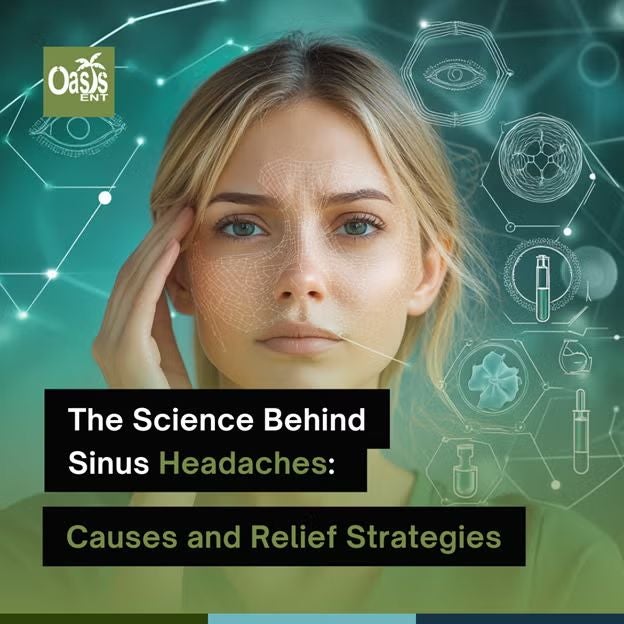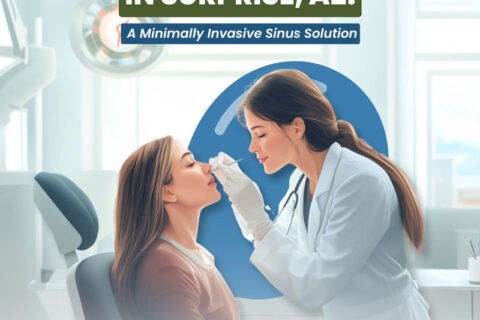The Science Behind Sinus Headaches: Causes and Relief Strategies
Headaches are a common symptom of sinus infections. If you experience pain behind your eyes, foreheads, cheekbones, or the bridge of your nose, you might be experiencing something more than a normal headache–what you might be dealing with are sinus headaches.
Sinus headaches are nothing new—they may not be life-threatening, but they can certainly be painful and uncomfortable. Let’s explore how sinus issues and headaches are connected and discuss ways to find relief.

The Science Behind Sinus Headaches
Headaches are a common symptom of sinus infections.
There are air-filled spaces behind the nose, cheekbones, and forehead known as sinuses. The linings on the sinuses naturally produce mucus to moisturize, humidify the air we breathe, and trap airborne contaminants. The sinus passages naturally drain the mucus. However, the sinuses can become irritated and inflamed due to irritants, allergens, and triggers.
When the sinuses become inflamed and infected, mucus cannot drain properly, resulting in mucus buildup and nasal congestion. This increases the risk of infections due to germs, viruses, and bacteria. Sinus infections can manifest as blocked nasal passages, postnasal drip, runny nose, facial pain, and sinus headaches.
To tell a sinus headache apart from a regular headache, look at when the headache started. If the headache started as part of a recent sinus issue like an infection, cold, or allergy, then it is most likely a sinus headache.
You can consult with your care provider to get a proper diagnosis and they will conduct a physical examination to know for sure. Imaging tests like X-rays or CT scans may also be an option for a more accurate diagnosis.
Sinus Headaches: What Are They and What Causes Them?
Sinus headaches are characterized as a dull pain behind the eyes, cheekbones, forehead, and the bridge of the nose. This type of headache is typically associated with sinus infections, hence the name. When you experience headaches in any of these areas when you have an ongoing sinus infection, what you’re experiencing is most likely a sinus headache.
Sinus headaches result from the build-up of pressure in the sinuses. When the sinuses are inflamed and swollen due to an infection, there is constant pressure in the sinus cavities resulting in headaches. There are also factors of mucus buildup resulting in nasal congestion that can intensify the headaches.
The pain typically gets stronger when you bend over or make sudden changes in the position of your head. One can differentiate between a regular headache and a sinus headache because the latter often causes facial pain and pressure.
Here are common signs of sinus headaches:
- Pain and pressure in the face–behind the eyes, cheeks, forehead, and bridge of the nose
- The pain worsens with sudden head movements
- Bending over or lying down makes the pain worse
- The headache starts when the sinuses are acting up
- Runny nose and nasal congestion
- Pain in the teeth
Sinus Headaches: Tips for Relief
Sinus headaches are a symptom of sinusitis. To find relief from sinus headaches, the underlying infection must be addressed first.
Medications
There are various medications that can help you manage sinusitis symptoms, including sinus headaches:
- Antibiotics may be prescribed if your care provider finds that the underlying infection is due to bacteria–they don’t work for infections caused by viruses.
- Pain relievers can help minimize headaches and facial pain associated with sinusitis.
- Decongestants reduce nasal blockages and provide relief for irritated sinuses.
- Corticosteroids can reduce sinus inflammation.
- Antihistamines can effectively manage allergy symptoms.
At-home approaches
There are also tried and tested at-home approaches that can help manage sinus headaches:
- Steam inhalation breaks down mucus buildup and moisturizes dry and irritated sinuses.
- Warm compress on the painful areas can help ease pain and discomfort.
- Indoor humidifiers can add moisture to the air–the lack of moisture in the air can dry and irritate the sinuses, increasing the risk of infections.
Consult with a specialist
If all else fails, you might want to consider seeing a specialist for your sinus headaches, especially if the symptoms don’t seem to go away.
At Oasis ENT, we are deeply committed to helping our patients get to the bottom of their sinus issues by providing them with appropriate coping and treatment strategies. Schedule a consultation with us today and let’s start talking about how you can breathe better!
Disclaimer: This blog is for informational purposes only and should not be considered medical advice. Always consult a licensed healthcare professional regarding any medical condition or treatment.
The information provided in this article is for informational and educational purposes only and does not constitute medical advice. It is not intended to diagnose, treat, cure, or prevent any disease or medical condition. Always seek the guidance of your physician or other qualified healthcare provider with any questions you may have regarding a medical condition or treatment.
Results may vary: Treatment outcomes and health experiences may differ based on individual medical history, condition severity, and response to care.
Emergency Notice: If you are experiencing a medical emergency, call 911 or seek immediate medical attention.


